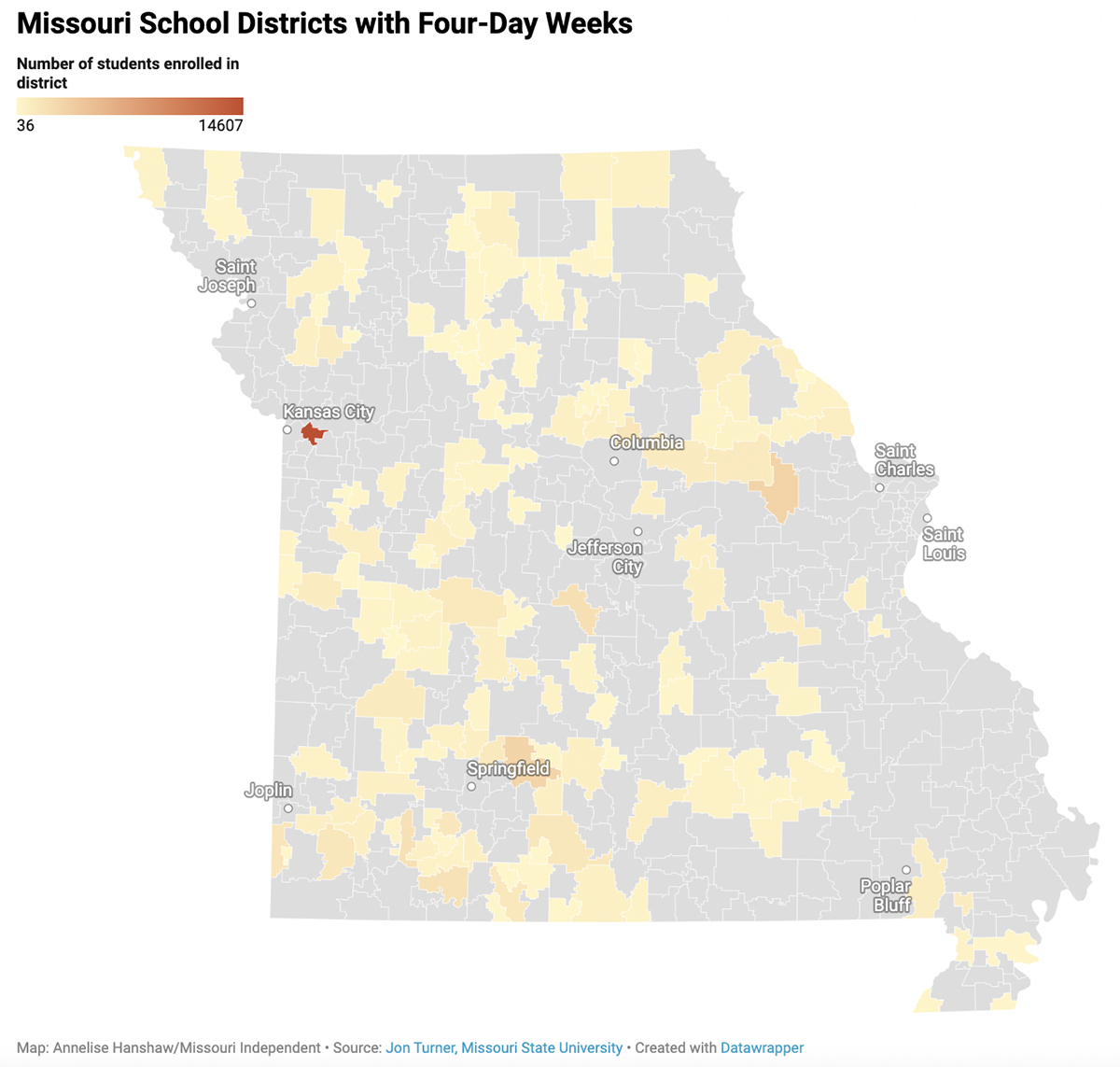Another Symptom of Missouri Teacher Shortage: Growing Number of 4-Day School Weeks
Independence School District became the largest in the state to switch to an abbreviated school week in an attempt to improve teacher retention

Get stories like this delivered straight to your inbox. Sign up for The 74 Newsletter
Over a quarter of Missouri school districts learn on a four-day schedule. And up until last week, they were small, rural districts – some with as few as 50 students.
That changed when Independence School District voted to implement the schedule for its 14,000 students next fall.
Missouri policymakers are taking notice, with varying ideas to deal with the key factor for many districts’ shift to a four-day week: Teacher recruitment and retainment.
Four-day school weeks have been growing exponentially across Missouri’s rural school districts since 2009. That year, the state legislature removed a requirement that set a minimum number of days schools must open their doors, leaving a mandate for 1,044 hours of learning.
Roughly 12% of the state’s public school K-8 students now attend class four days per week, according to Missouri Department of Elementary and Secondary Education and Missouri State University College of Education data.
Only two of the districts educate over 3,000 students, meaning Independence will be by far the largest in Missouri to make the switch.
“Just the sheer magnitude of the size of the school district makes them a unique case,” said Jon Turner, an associate professor at Missouri State University studying the implementation of the four-day school week.
Kansas City Mayor Quinton Lucas voiced concerns on Twitter, calling for salary raises for educators and naming a four-day school week a “gimmick.”
“I am concerned this is more about adults than our kids. I hope I am wrong,” he wrote.
Motive
Dale Herl, superintendent of the Independence School District, starred in a few short videos explaining the four-day school week to families in the run up to the school board’s vote. The first video made it clear what the district’s motivation was for cutting Mondays off the schedule.
“The main thing, looking at this, is we wanted to see if it would help retain and recruit staff,” he said.
State Rep. Doug Richey, R- Excelsior Springs and co-chair of the legislature’s Joint Committee on Education, said an employment perk is what he hears as the key reason for switching to a four-day school week.
Turner has watched rural districts adopt a four-day week in order to have a large enough workforce to operate. Now, he said he wonders if larger districts are having the same problem.
“The dynamic of the four-day week is that many of those districts are smaller, rural school districts, and where they lose their competitive angle is with mid- and late-career teachers,” Turner said.
Department of Elementary and Secondary Education data shows that 40.5% of Missouri teachers are leaving their school districts after three years. In Independence, that rate is slightly higher, with 43.7% choosing to leave their positions.
A four-day work week, which is growing in popularity in the tech industry, is pitched as an incentive for school staff to stay loyal to their professions and the district.

Teacher pay
Senate Minority Leader John Rizzo, D-Independence, doesn’t just represent the state’s newest four-day school district. His children also attend and he expressed frustration with the district’s decision in an interview with The Independent.
Rizzo said he and his wife are considering taking their children out of their current schools.
He wants to see the state increase its investment in public education.
“We’re at the bottom when it comes to teacher pay, and we’re expecting miracles. We shouldn’t educate on miracles,” he said. “We should educate on dollars and cents and in fully funding the schools in our state.”
Missouri ranks 50th in the nation for the average teacher starting salary, paying new educators an average of $33,234, according to the National Education Association. The state is 47th for overall teacher salary, paying an average of $51,557.
Richey touts local control, wary of raising the state’s minimum wage for educators.
He pointed to Hickman Mills School District, which is also located outside of Kansas City. The district is raising teacher salaries with an operational levy passed by voters in August.
Independence pays teachers an average salary of $53,528, according to DESE data. The Lee’s Summit R-7 School District, located less than 30 minutes away, pays an average of $64,350; less than 30% of its educators leave the district after three years.
“Unless the taxpayers are really ready to kick in with a much higher salary to compensate these people, the only way we can [retain teachers] is by figuring out ways within the schedule, like four days a week, that seem to be attractive to people,” Turner said.
He said he has heard anecdotal evidence that educators are leaving higher-paying jobs to teach at schools that operate four days per week.
Numerous bills filed ahead of the upcoming legislative session address the apparent shortage of teachers. Multiple suggest raising the minimum teacher salary to $38,000.
The current minimum is $25,000, but a one-year grant program allowed participating schools to raise their salary floors to $38,000 with a year of state help.
“I wasn’t entirely excited about that because it’s a one-year grant program. And districts really can’t plan around that,” said Richey, who also serves on the House Budget Committee. “I just thought that was more of a band-aid approach.”
This month, DESE released its legislative priorities. Sitting atop the list is raising teachers’ minimum wage to at least $38,000, along with urging the legislature to establish a fund to help districts afford the higher salaries.
Research
Turner said he can’t predict whether Independence’s shift will help or hurt student outcomes. Either way, he says the impact will be small.
“I have not seen any data that has said over the long term – and I’m talking about more than five years – that you’re seeing long-term negative or positive impacts of the four-day week,” he said.
He said it could help keep high-quality instructors around students, but the kids could suffer from more memory loss over longer weekends.
The weekday students are home also allows for more professional development than teachers could otherwise get on the calendar, Turner said.
Oregon State University and NWEA researchers looked at standardized test scores across multiple states over 12 years and tracked academic growth. They found that schools with four-days per week had less academic growth, especially in urban areas.
The effect gets worse the more years a school meets only four days per week, the researchers write.
But they were not able to measure how many hours of instruction students get annually.
Another study, by researchers at Oregon State and the RAND Corporation, divided their data into three categories: Low, medium and high-time at school.
Only those with a low amount of time in the classroom had negative effects from the four-day schedule, they wrote.
Independence School District will be adding 35 minutes to each day, so students will not lose the equivalent of an entire day of class, the district said in an informational video.
Fifth day
Independence will provide its after school program, called “Kids Safari,” on the weekday students have off for Kindergarten through eighth grade.
But it would not be free.
Families can utilize childcare on Mondays for elementary and middle-school-aged children for $225 per year per child. Transportation is not provided.
Rizzo described Independence as a “blue-collar, hard-working, middle-class area.” He didn’t know the district’s plan for the fifth day yet, but he said having something would be important to families.
A way he’ll measure the four-day school week’s success is by the district’s enrollment numbers the following year.
Richey said he will be looking at the absenteeism rate and measures of teacher morale. Then, around five years from now, a successful program should have improved test scores, he said.
Missouri Independent is part of States Newsroom, a network of news bureaus supported by grants and a coalition of donors as a 501c(3) public charity. Missouri Independent maintains editorial independence. Contact Editor Jason Hancock for questions: [email protected]. Follow Missouri Independent on Facebook and Twitter.
Get stories like these delivered straight to your inbox. Sign up for The 74 Newsletter

;)